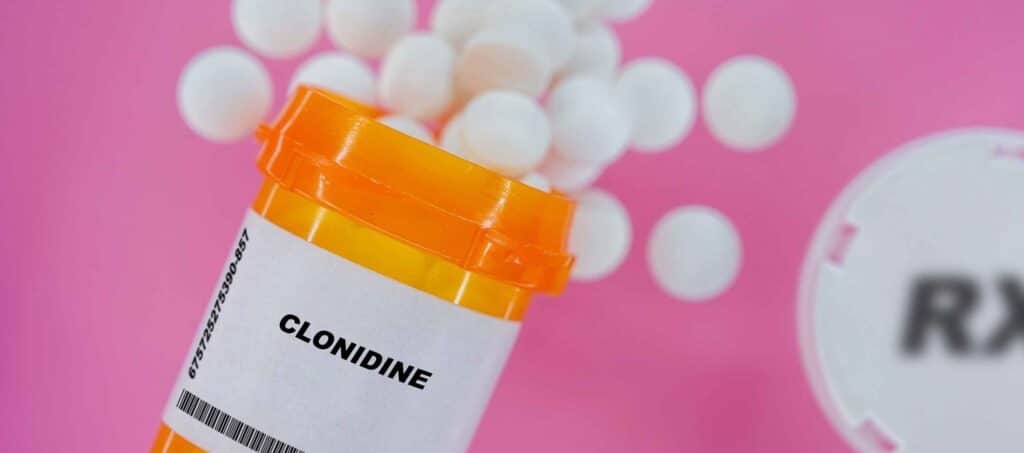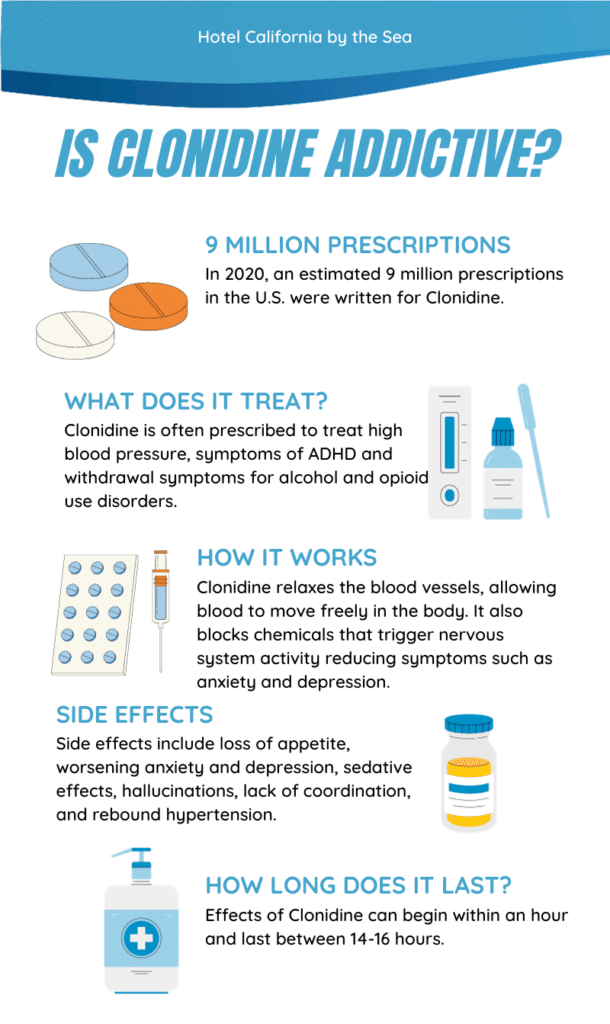Is Clonidine Addictive?
In 2016, over 10 million prescriptions of Clonidine were issued. This made it the 79th most prescribed medication in the U.S. Fast forward to 2020, an estimated 9 million prescriptions have been written for Clonidine. Despite the slight decline in the recommendation of Clonidine use, it is still a popularly prescribed medication used to treat a variety of conditions. Clonidine is a class of prescription medications called antihypertensives. The drug was first approved over 40 years ago to treat conditions of high blood pressure as well as a handful of off-label uses such as treating ADHD, Tourette syndrome, cancer-related pain, opioid withdrawal symptoms and alcohol withdrawal symptoms.
Common brand names for Clonidine include Catapre, Kapvay and Nexiclon. Common street names for Clonidine include chill pills, downers, candy and tanks. The synthetically derived drug can be ingested orally, intravenously, topically or through snorting. The medication often comes in a tablet or patch form. Where the patch form will deliver a constant amount of medication and can take up to 2 days for the patch to reach a steady state.
The effects last up to 16 hours and on average and eliminated from the body between 48-72 hours. When used to treat abnormal or high blood pressure, treatment can take between 2-4 weeks to see results. Medical professionals also prescribe this medication for the treatment of ADHD in young people, making it easier for them to manage and control their behaviors.

Clonidine has also been used to help ease withdrawal symptoms for those in treatment for opioid use disorder and alcohol use disorder. It is used in about 80% of treatments during the detox process under medication-assisted treatments (MAT) as well as other forms of medication management. When on Clonidine, the detox process can last 7 days. For withdrawal symptom management, Clonidine helps decrease the body’s reaction to the removal of mind-altering chemicals. It helps lower anxiety, reduce symptoms of insomnia and PTSD and can bring relief from hot and cold flashes. Ultimately, it can make the detox process much more bearable.
Clonidine is considered one of the best medication treatments for opioid withdrawal. This is because it is not considered a scheduled medication so it does not contain euphoric effects and has a low potential for addiction.
Clonidine impacts the receptors in the prefrontal cortex of the brain. This area is associated with behaviors such as impulsivity, hyperactivity and inattentiveness. These are all symptoms of attention deficit hyperactivity disorder, which makes it a commonly prescribed medication to treat these symptoms in young people who suffer from this condition. The prefrontal cortex of the brain is where much of the “executive” functions occur. Functions such as planning, organizing and using learned information and experiences. Clonidine affects this area by creating a sense of mild sedation that results in both mind and body relaxation.
The drug works by relaxing blood vessels, which allow blood to move more freely without restrictions throughout the body. This makes it easier for the heart to pump blood, which helps to lower blood pressure. Clonidine also blocks chemicals in the brain that trigger sympathetic nervous system activity. This helps reduce uncomfortable symptoms of opioid and alcohol detox as well as minimize symptoms of anxiety, sweating, hot flashes and restlessness. Because Clonidine works on relaxing both the brain and body, is it possible to develop a Clonidine addiction?

Is Clonidine Addictive?
Clonidine was first created in 1966 as a treatment for lowering high blood pressure. Later, it was approved by the FDA in 2010 to treat symptoms of ADHD. Today it has many other off-label uses. It is not a DEA-controlled substance and technically has a very low potential for abuse. However, like other mood-altering substances that are misused, Clonidine can become addictive.
Blood vessels are relaxed and able to lower blood pressure and sympathetic outflow of the CNS reduces anxiety and produces a mild sense of euphoria and pain relief. In other words, taking Clonidine can give the user the sensation of feeling relaxation. And with consistent and increased use, this could lead to tolerance, dependence and addiction. Though it does not produce intense “high” or intense pleasurable sensations, the slight drowsing effects can cause a person to become addicted.
Signs of Clonidine Addiction
- Intense urges for Clonidine
- Feeling the need to use it regularly
- Finding they are taking more of the substance in order to achieve the same effects
- The need to always have a backup for Clonidine
- Spending more on Clonidine than is financially responsible
- Having no intentions of quitting
- Clonidine has affected and disrupted daily life
- Experiencing withdrawal symptoms once usage has decreased or completely stopped
Check Your Insurance Coverage for FREE
Find out if your insurance covers addiction treatment in minutes. We accept most insurance!
Side Effects of Clonidine Abuse
- Nausea and vomiting
- Weakness
- Headache
- Loss of appetite
- Dry mouth
- Worsening anxiety and depression
- Drowsiness
- Irregular heartbeat and heart palpitations
- Fever
- Itchy skin
- Restlessness
- Swelling of feet or lower legs
- Sedative effects
- Hallucinations
- Difficulty falling asleep and other sleep conditions
- Lack of coordination
- Slurred speech
- Rebound hypertension – significant increase in blood pressure
According to the National Survey on Drug Use and Health, in 2016, an estimated 497,000 Americans age 12 and older reported misusing prescription sedatives such as Clonidine. Clonidine is not high on the list of addictive substances. In fact, it is a medication often used to help treat those with other types of substance addictions such as opioids, alcohol and benzos. But, substances with the ability to alter a person’s mind by affecting the central nervous system, can pose a risk for addiction.
Reach out to Hotel California by the Sea
We specialize in treating addiction and other co-occurring disorders, such as PTSD. Our Admissions specialists are available to walk you through the best options for treating your addiction.
Hotel California by the Sea provides unique treatments to help users who may have a substance addiction or prescription drug addiction. The prescription drug treatment program consists of detox, residential, PHP and IOP programming. Hotel California by the Sea believes in creating individualized treatment plans for each client. There is no one-size-fits-all when it comes to addiction recovery. Specialized treatments such as family therapy, EMDR therapy and CBT, are evidence-proven treatments to help people with addiction disorders. A combination of medication treatments and intensive therapies will help clients overcome their addiction and live a healthier life in sobriety.
References:
https://www.addictioncenter.com/treatment/medications/clonidine/
https://www.help.org/clonidine-addiction/
https://www.ncbi.nlm.nih.gov/books/NBK459124/
https://www.rehabspot.com/treatment/medical/addiction-treatment-medications/clonidine/
https://www.verywellmind.com/clonidine-for-adhd-symptoms-4125406
https://www.addictionhelper.com/treatment-rehab/medication/clonidine/
https://www.addictionresource.net/controlled-substances/clonidine/
https://www.bicyclehealth.com/blog/what-is-clonidine-how-does-clonidine-work
